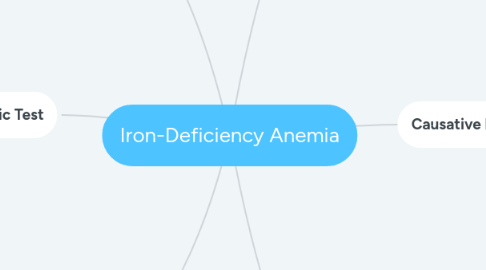Iron-Deficiency Anemia
Steven Bertaにより

1. Pathophysiological Etiology
1.1. Decreased total iron body content that causes diminished erythropoiesis leading to anemia
1.2. depletion results from blood loss, impaired absorption, decreased intake, and increased demand for iron
1.3. common due to blood loss with hemoglobin levels below 7 to 8 being severly low
1.4. Heme enters cells as metalloporphyrin, degrades the enterocyte by heme oxygenase.
1.5. Ferric iron enters by blocking antibodies against DMT-1 and beta3-integrin
1.6. Most iron is absorbed through diet and by the the GI tract.
2. Causative Factors
2.1. Based on age, gender and socioeconomic status
2.2. Parasitic helminthiasis due to hookworms binding to the small intestinal mucosa is the most common cause worldwide
2.3. insufficient iron intake, and decreased absorption
2.4. blood loss or hemmorrhage is most common cause
2.5. low dietary intake of iron such as: celiac disease, little greens, red meat, iron-fortified milk formulas
2.6. Pregnancy
3. Risk Factors
3.1. Can occur at any age, race, and gender
3.2. women who are childbearing age or pregnant are more at risk
3.3. Poor diets to include low iron filled foods, lack of greens, vegetarians, and red meat not eaters
3.4. premature infants
3.5. frequent blood donators
4. Diagnostic Test
4.1. Complete Blood Count (CBC)
4.2. Reduced Hgb, Hct results and pRBC size
4.3. Low Ferritin, hemoglobin, mean corpuscular volume, mean corpuscular hemoglobin
4.4. High total iron-binding capacity, transferrin, pRBC width'
4.5. Blood smear differential with results of low RBC, and shows poilkilocytosis
5. Common Findings
5.1. Fatigue and diminished level of energy
5.2. Irritability, angina, palpitations, breathlessness, tingling, poor appetite, dysphagia, and restless leg syndrome
5.3. cold intolerance, reduced infection resistence, altered behavior, poor phyiscal performance during exercise, comorbid cardiac and pulmonary diseases
5.4. Impaired physical growth in infants
5.5. Pallor, spoon shaped nails, glossy tongue, fissures at corners of mouth
5.6. Splenomegaly
5.7. Seen in adolescents girls with heavy menstrual cycles, CHF, Renal transplants, and bariatric surgery recipients.
6. Treatment
6.1. Oral iron supplements daily up to 200mg daily
6.2. blood transfusions
6.3. intravenous iron supplement
6.4. Incorporation of iron-rich foods in diet
6.5. Increase Vitamin C or ascorbic acid
6.6. Monitor for constipation as iron supplements can increase constipation
6.7. erythropoietin injection post dialysis


